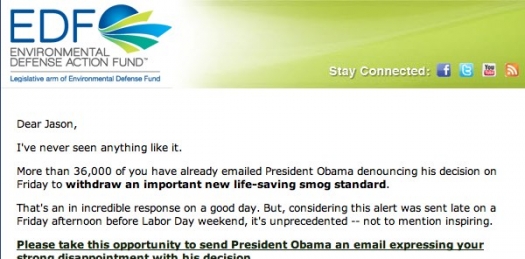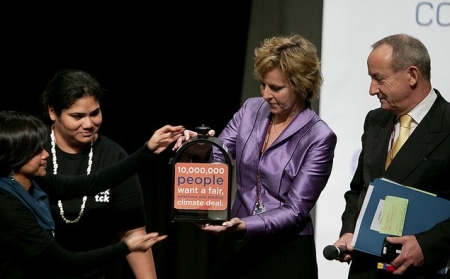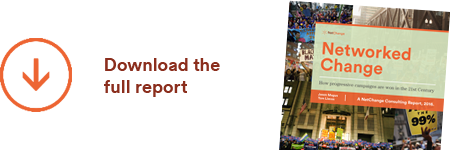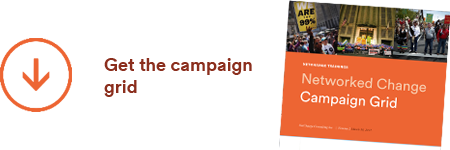It’s been heartening watching the environmental NGO community finally take up arms against US President Obama’s weak environmental record this past week. The bold leadership with clear, direct statements has been inspiring, with their threats to pull their support and the positive response from their supporters to do so marking a rare movement wide high point.
Unfortunately, these groups still act like isolated individual brands and not movement allies, which I think greatly misses the impact of their efforts. In emails, on the web, and to the media, they talk to their supporters like they are the only ones out there doing this heroic work. They only show public support response numbers from their own supporters. They never mention or even allude to the fact that nearly every green group is engaged in the same fight at the same time!
Not to pick on just one but this is an email I received this week:

36,000 people? Really, that’s impressive? Don’t you think if they publicly combined forces with other groups, added up their supporters into a much larger number, and highlighted the great work each other is doing this would be more inspiring to their supporters, have more weight with the media, and be more of a scare to the administration itself?
I speak with some experience here because this is exactly what we did for the UN climate summit in Copenhagen. Working with the TckTckTck campaign our role was to “align, aggregate, and amplify” the global climate movement, with the idea that decision makers predicted the opposition of western green groups, but if we could show up together as a diverse, unified, global movement – that spanned many issues and had a huge momentum of supporters – world leaders might just listen.
It was our role as the digital strategy lead to figure out how to show the power of this movement to the media and the leaders. This was not an easy task, as the coalition consisted of hundreds of diverse NGO’s, most of whom had different goals and vastly different tactics. Even the quasi-independent national offices of the biggest brands like Oxfam, WWF, and Greenpeace all did different things from each other!
In the end, our solution was dead simple: pretty much everyone tries to grow their email lists and show public support on issues through online petitions, so what if we added up all those actions into one big number? It wasn’t a popular idea, and many of the big groups ignored our efforts at first. But we kept chipping away at it, and our decidedly low tech solution – a google doc and good old fashioned elbow grease of prodding our digital counterparts for their latest numbers of support from their own databases – did the trick.
 And boy, did it work. The day we launched the site, we had aggregated over 1M signups. Every key moment of the campaign added more, with Avaaz’s climate petitions adding a big boost, 350’s Global Day of Action giving us 1M sign-ups in one day (real world actions to boot!), and Oxfam’s “climate witness” events across the global south bringing over 2M. On the first day of the summit, we had 11M signatures. By the end of the talks, that number had ballooned to more than 15,000,000!
And boy, did it work. The day we launched the site, we had aggregated over 1M signups. Every key moment of the campaign added more, with Avaaz’s climate petitions adding a big boost, 350’s Global Day of Action giving us 1M sign-ups in one day (real world actions to boot!), and Oxfam’s “climate witness” events across the global south bringing over 2M. On the first day of the summit, we had 11M signatures. By the end of the talks, that number had ballooned to more than 15,000,000!
 By the end of the campaign, over 17M people from every country on earth but one had signed on to push world leaders for a climate deal. Not bad for 4 months of campaigning. And a heck of a lot more impressive than any of the actions the individual groups produced working alone.
By the end of the campaign, over 17M people from every country on earth but one had signed on to push world leaders for a climate deal. Not bad for 4 months of campaigning. And a heck of a lot more impressive than any of the actions the individual groups produced working alone.
So hence my challenge to the American environmental community: Add it up boys!
- Stop pretending you work in a vacuum and are the only green group of note in the country
- Start adding up the supporter actions from other major movement players into much more impressive numbers
- Tell stories about your allies when they do inspiring work in alignment with your goals
- Heck, maybe even link to their actions from time to time to give each other a boost! Let’s create some network effects that raise all boats!
We are well aware of the risks of collaborating in this way – largely coming from the fundraisers (doing amazing, hard work) who are protective of supporter lists and whose role is not only to help win on issues but to build the brands of the institutions fighting for them. This is natural behaviour, and probably wise most of the time. But it’s also small minded. These times require bigger thinking.
My friends, who is willing to step up and show bold leadership in new, networked models of campaigning?
Jason Mogus is Communicopia’s principal consultant and is the founder of Web of Change. He has been developing digital strategies for social change organizations for over 15 years. You can follow him at @mogusmoves.









